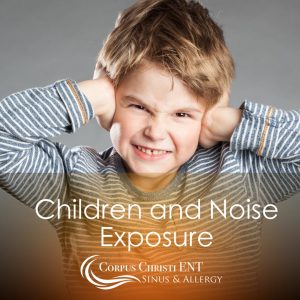
As adults we may realize that sounds are noisy, and that sounds we are exposed to at work or during recreational activities can affect our hearing. What many people don’t realize is that children are often exposed to dangerous levels of sounds and often times we are the ones exposing them to these sounds.
In recent years we have probably all seen pictures from the Super Bowl where famous football players are holding their small children during the celebrations and the children are wearing ear muffs. This is just one example of noise exposure, and if you have ever attended a live sporting event of that magnitude you can understand how loud that can be. But what many of us don’t understand is how much noise we expose children to in their daily lives.
Many infant and children’s toys are capable of producing dangerous levels of sounds.
In fact there are Consumer safety reports that identify these toys and there have been movements towards labeling noise outputs on certain toys. Horns, megaphones, buzzers, etc., can all be very loud. Children don’t know the dangers of putting these toys next to their ears (or other people’s ears) and setting off the sounds.
We also live in a world dominated by electronics. You can’t walk down the street or into a store without seeing someone “plugged in” to their technology. Wearing headphones or earbuds in itself is not such a bad thing, unless the volume is too high. Just like for adults, the general rule of thumb is no more than 50% volume for 2 hours per day. But how do we make sure children aren’t exceeding this? One solution is Volume Limiting headphones. These headphones automatically reduce the volume by a certain amount. So even though the volume dial may say full volume, the child actually is only hearing at ¾ volume. Some devices have a parental volume control built in as well. For example, the baby Kindle from Amazon has parental controls for many features, including volume.
Additionally, we must be mindful when we take children along with us for activities. I’ve seen children who accompany their adult family members when they go shooting or hunting. The adults think that since the child isn’t shooting the gun and they will be sitting farther back, they can just hold their hands over their ears and that will be enough. It’s not! Gun shots are considered an acoustic trauma because they are so loud. It only takes one gun shot to start to damage delicate ear structures. Even one child with a noise induced hearing losses before they are 10 years old is too many.
As adults, we need to be mindful of the noises we are exposing our children to. Today’s world is different from the one we grew up in. Our children wear bicycle helmets, wear elbow and knee pads, ride in car safety seats, and safety glasses. They should wear hearing protection too when they are going to be exposed to loud sounds. We should also recognize when sounds are too loud and turn them down if we can, or move farther away, and monitor electronic devices our children use.
If you are concerned about your child’s hearing, ask an Audiologist.